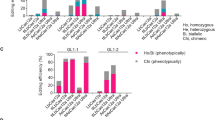Abstract
Sequences of three Arabidopsis thaliana and two Brassica napus cDNAs encoding squalene monooxygenase homologues (Sqp1 and Sqp2) are reported. Southern analysis confirmed that these cDNAs are derived from small gene families in both species. Expression analysis indicates that Sqp1 genes in B. napus are strongly expressed in leaves but not roots or developing seeds. Comparison of cDNA and genomic sequences indicate that the 3′ splice site of an intron in these genes has undergone junctional sliding. The evolutionary significance of this phenomenon is discussed.
Similar content being viewed by others
References
Cavalier-Smith T: Intron phylogeny: a new hypothesis. Trends Genet 7: 145–148(1991).
Chappell J: Biochemistry and molecular biology of the isoprenoid biosynthetic pathway in plants. Annu Rev Plant Physiol Plant Mol Biol 46: 521–547(1995).
Craik CS, Rutter WJ, Fletterick R: Splice junctions: association with variation in protein structure. Science 220: 1125–1129(1983).
Dellaporta SL, Wood J, Hicks JB: A plant DNA minipreparation: version II. Plant Mol Biol Rep 1: 19–21(1983).
Doolittle WF: What introns have to tell us: hierarchy in genome evolution. Cold Spring Harbor Symp Quant Biol 52: 907–913(1987).
Elledge SJ, Mulligan JT, Ramer SW, Spottswood M, Dais RW: LambdaYes: a multifunctional cDNA expression vector for the isolation of genes by complementation of yeast and Escherichia coli mutations. Proc Natl Acad Sci USA 88: 1731–1735(1991).
Favre B, Ryder NS: Differential inhibition of fungal and mammalian squalene epoxidases by the benzylamine SDZ SBA 586 in comparison with the allylamine terbinafine. Arch Biochem Biophys 340: 265–269(1997).
Funabiki T: Oxygenases and Model Systems. Kluwer Academic Publisher, Dordrecht, Netherlands (1997).
Gilbert W: The exon theory of genes. Cold Spring Harbor Symp Quant Biol 52: 901–905(1987).
Gilbert W, de Souza SJ, Long M: Origin of genes. Proc Natl Acad Sci USA 94: 7696–7703(1997).
Gilbert W, Glynias M: On the ancient nature of introns. Gene 135: 137–144(1993).
Goodall GJ, Filipowicz W: Different effects of intron nucleotide composition and secondary structure on pre-mRNA splicing in monocot and dicot plants. EMBO J 10: 2635–2644 (1991).
Higashimoto Y, Liddle RA: Isolation and characterization of the gene encoding rat glucose-dependent insulinotropic peptide. Biochem Biophys Res Commun 193: 182–190(1993).
Jandrositz A, Turnowsky F, Högenauer G: The gene encoding squalene epoxidase from Saccharomyces cerevisiae: cloning and characterization. Gene 107: 155–160(1991).
Jellie AM, Tate WP, Trotman CNA: Evolutionary history of introns in a multidomain globin gene. JMol Evol 42: 641–647 (1996).
Ko CH, Brendel V, Taylor RD, Walbot V: U-richness is a defining feature of plant introns and may function as an intron recognition signal in maize. Plant Mol Biol 36: 573–583 (1988).
Kosuga K, Hata S, Osumi T, Sakakibara J, Ono T: Nucleotide sequence of a cDNA for mouse squalene epoxidase. Biochim Biophys Acta 1260: 345–348(1995).
Martinez P, Martin W, Cerff R: Structure, evolution and anaerobic regulation of a nuclear gene encoding cytosolic glyceraldehyde-3-phosphate dehydrogenase from maize. J Mol Biol 208: 551–565(1989).
May KE, Cerelli GM, Rosenfeld MG, Evans RM: Characterization of cDNA and genomic clones encoding the precursor to rat hypothalmic growth hormone-releasing factor. Nature 314: 464–466(1985).
Müller K, Schmitt R: Histone genes of Volvox carteri: DNA sequence and organization of two H3-H4 gene loci. Nucl Acids Res 16: 4121–4136(1988).
Nagai M, Sakakibara J, Wakui K, Fukushima Y, Igarashi S, Tsuji S, Arakawa M, Ono T: Localization of the squalene epoxidase gene (SQLE) to human chromosome region 8q24.1. Genomics 44: 141–143(1997).
Newman T, de Bruijn FJ, Green P, Keegstra K, Kende H, McIntosh L, Ohlrogge J, Raikhel N, Somerville S, Thomashow M, Retzel E, Somerville C: Genes galore: a summary of methods for accessing results from large-scale partial sequencing of anonymous Arabidopsis cDNA clones. Plant Physiol 106: 1241–1255(1994).
Palmer JD, Logsdon JM Jr: The recent origin of introns. Curr Opin Genet Dev 1: 470–477(1991).
Rogers J: Introns between protein domains: selective insertion or frameshifting? Trends Genet 12: 223 (1986).
Rogers JH: How were introns inserted into nuclear genes. Trends Genet 5: 213–216(1989).
Sakakibara J, Watanabe R, Kanai Y, Ono T: Molecular cloning and expression of rat squalene epoxidase. J Biol Chem 270: 17–20(1995).
Sambrook J, Fritsch EF, Maniatis T: Molecular Cloning: A Laboratory Manual, 2nd ed. Cold Spring Harbor Laboratory Press, Cold Spring Harbor, NY (1989).
Satoh T, Horie M, Watanabe H, Tsuchiya Y, Kamei T: Enzymatic properties of squalene epoxidase from Saccharomyces cerevisiae. Biol Pharm Bull 16: 349–352(1993).
Stoltzfus A, Logsdon JM Jr, Palmer JD, Doolittle WF: Intron 'sliding' and the diversity of intron positions. Proc Natl Acad Sci USA 94: 10739–10744(1997).
Stoltzfus A, Spencer DF, Zuker M, Logsdon JM Jr, Doolittle WF: Testing the exon theory of genes: the evidence from protein structure. Science 265: 202–207(1994).
Thompson JD, Higgins DG, Gibson TJ: CLUSTAL W: improving the sensitivity of progressive multiple sequence alignment through sequence weighting, position-specific gap penalties and weight matrix choice. Nucl Acids Res 22: 4673–4680 (1998).
Trotman CNA: Introns-early: slipping lately? Trends Genet 14: 132–134(1998).
Wang C-S, Vodkin LO: Extraction of RNA from tissues containing high levels of procyanidins that bind RNA. Plant Mol Biol Rep 12: 132–145(1994).
Wierenga RK, Terpstra P, Hol WGJ: Prediction of the occurrence of the ADP-binding βα β-fold in proteins, using an amino acid sequence fingerprint. J Mol Biol 187: 101–107 (1986).
Yates PJ, Haughan PA, Lenton JR, Goad LJ: Effects of terbinafine on growth, squalene, and steryl ester contents of a celery suspension culture. Pesticide Biochem Physiol 40: 221–226(1991).
Author information
Authors and Affiliations
Rights and permissions
About this article
Cite this article
Schäfer, U.A., Reed, D.W., Hunter, D.G. et al. An example of intron junctional sliding in the gene families encoding squalene monooxygenase homologues in Arabidopsis thaliana and Brassica napus*. Plant Mol Biol 39, 721–728 (1999). https://doi.org/10.1023/A:1006172120929
Issue Date:
DOI: https://doi.org/10.1023/A:1006172120929




